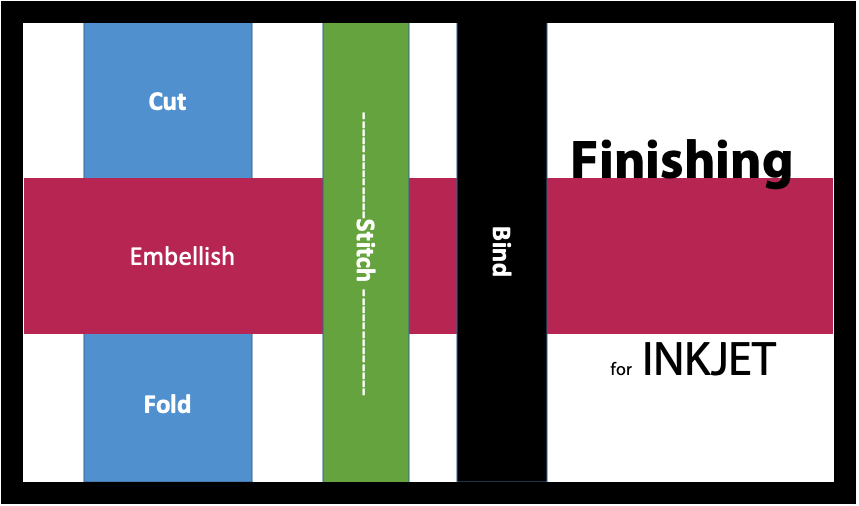We use the term finishing in print to cover activities that include sheeting from a printed roll, adding perforations, folding, binding, and inserting. Each is a touchpoint in a workflow based on its product and its final delivery format. A typical printing operation builds their finishing plan based on the products they offer and how they want the work to move through the plant. That is why some operations use inline finishing while others opt for nearline and offline finishing. When you add inkjet capability, does your finishing have to change?
The answer is – maybe! Let’s look at a few scenarios based on a move to inkjet.
Sheet Fed to Sheet-Fed Inkjet
Your sheetfed environment may be offset or toner, or you may have both. They may share finishing lines, or you may have built dedicated workflows to dedicated finishing lines. There may be a variety of options for finishing based on the products you produce. Finishing lines for books are configured differently from posters or print-and-mail for direct mail or transaction print. That investment was significant, so can you use it when you bring in your sheetfed inkjet device?
In many cases, you can use the same finishing but look at the format sizes. Is your sheet size of the inkjet device the same as the existing devices? Do they handle the same paperweights? If they seem to be compatible, test! You’ll want to see if the paper behaves the same and moves through finishing without jamming or picking up anomalies along the way.
It is also common to acquire sheetfed inkjet that adds a new sheet format to production. In these cases, look at your options. If you are acquiring a machine with a larger sheet size than your workflow currently uses, you may be able to add a step to cut down the sheet size to enter your workflow for at least some of your work. Think about that carefully, though. The larger sheet size may afford more efficiency that is optimally unlocked with new finishing solutions.
The good news in this situation you have time to review options. Talk to your equipment vendors. They see everything!
Sheet Fed to Web Inkjet
If you run a sheetfed shop but have opted for web-fed inkjet, you have likely run your numbers carefully. You decided based on the types of products you manufacture and the costs to create them. In most cases, buying finishing compatible with the new web-fed line is the plan. It may be inline or nearline depending on the plan.
Web inkjet is extremely fast, producing roll after roll in every production shift. Look at finishing that can keep up with the print device. This is not different from finishing in your sheetfed world, but the speed considerations may be different. Offset sheetfed production tends to be high speed and finishing is usually offline. Some shops maintain multiple finishing lines for optimum throughput. But if you have sheetfed toner devices, you may not be running at high speed. Your finishing may be set up for a different cadence.
Again, talk to your hardware vendors for their best advice. What you are trying to produce, whom you produce the work for, and the turnaround time demands should guide your selection of finishing devices. Those factors should also play a part in the inline/near line decision.
Web to Web Inkjet
This may seem obvious – of course. You can use the same finishing! Or can you?
Web offset presses might be replaced or augmented with web inkjet presses. If the workflow is built to take rolls and finish them near line, you may have options to share finishing. Some workflows are designed to create hybrid output where offset and inkjet pages are intermingled in the final product. Your hardware vendors can explain the options.
The same is true if you run web toner! You may find that the finishing equipment specifications and the workflow make it possible to share near-line finishing. Look at the finishing specifications for paperweight and other details. If you determine that it should work, great! But remember to test!
What to Look for in Testing
In every case, the recommendation is to test, but what should you be looking for? Here is a checklist for where to start:
Finishing Paper Path: Does the paper run smoothly? Is there any wiggle? Do you see paper shifting orientation after cutting or while folding?
Smudges: There are many ways to move paper through finishing. Any method that touches the paper can smudge ink, mark, or crease the paper, so look carefully at the output.
Misread OMR Marks or QR Codes: Many workflows use barcodes and other marks to direct finishing activities and to feed information back into their workflows. Don’t forget to test that the codes are read. And that they are read correctly! Changing to inkjet might require recalibration of cameras to ensure that data capture continues as expected!

